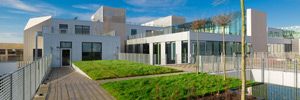 Blackdown says its single source approach to the design, growing, supply, installation and maintenance of green roof solutions was borne out of its desire to ensure that the highest quality standards are achieved.
Blackdown says its single source approach to the design, growing, supply, installation and maintenance of green roof solutions was borne out of its desire to ensure that the highest quality standards are achieved.
According to the company, its systems ensure the realisation of the key drivers that first inspire the specification of green roofs, such as stormwater retention, carbon consumption, air and water quality improvements, Urban Heat Island Effect reduction and habitat creation. It says one of its complete systems provides protection to the waterproofing layer; drainage of surplus stormwater; filtration; an appropriate growing medium; and a plant layer that is suited to a project’s microclimate. This combination provides the most sustainable, long-term green roof solution, which is especially important in a green roof market that has no prescriptive performance standards.
The term ?green roof’ applies to a whole spectrum of roofs, ranging from a fully landscaped roof garden to a substrate-free blanket of Sedum species. This broad definition leaves many specifications prone to value engineering, meaning the consequences of decisions to change or remove parts of the system are often not known, or accounted for, in the decision to ?value’ engineer. For example, changes to the specification of the growing medium will affect the roof’s ability to meet the plants’ air, water and nutrient requirements. If the growing medium is too porous, additional irrigation measures may be required. If it has too high a proportion of organic matter, there is a risk of water clogging the plants’ supply of air, leading to suffocation and higher than anticipated loadings.
Blackdown says green roofs deliver the kind of cost-effective, long-term solutions that have added value at some of the UK’s most prestigious buildings. One such example is the installation at the new SSE Hydro Arena in Glasgow, where the green roof – specified by Foster & Partners – was supplied and installed by Blackdown with the intention of achieving an aesthetically-striking and sustainable design feature comprising a dense plant cover with over 37,000 Lonicera Nitida “Maygreen” shrubs.




